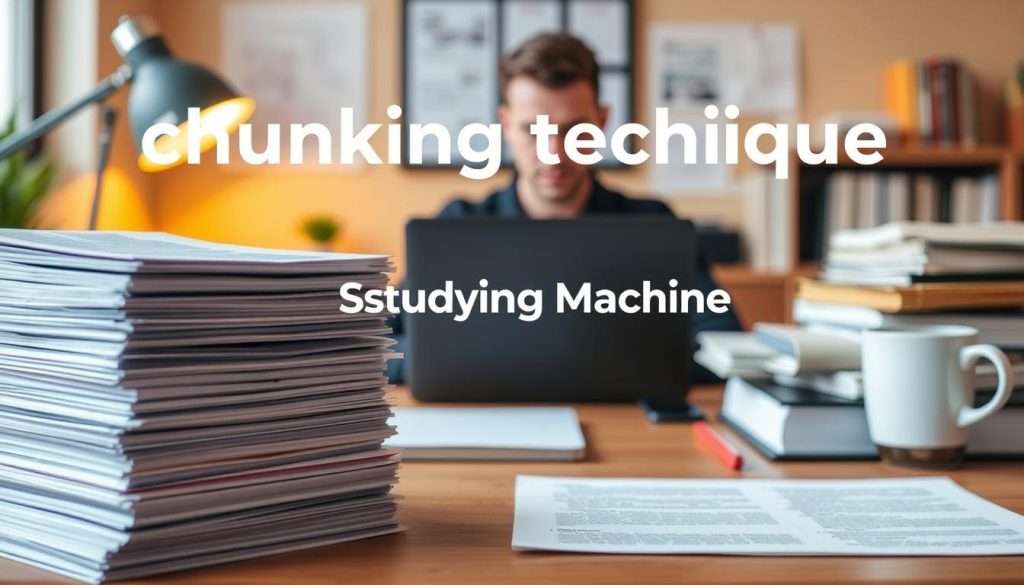Feeling overwhelmed by too much information? Boosting productivity is a goal for many. But, it’s hard with complex tasks or lots of data.
Here’s some good news! There’s a learning strategy that can help. By breaking down info into smaller pieces, studying becomes fun and effective.
The chunking technique is a simple way to boost productivity and memory. It helps you reach your goals faster.
Key Takeaways
- Break down complex information into manageable chunks to boost productivity.
- Improve retention by organizing data into smaller, more digestible pieces.
- Transform studying into an enjoyable, effective learning experience.
- Enhance your learning strategy with the chunking technique.
- Achieve your goals more efficiently by applying this simple yet effective method.
Understanding the Chunking Technique
Breaking down information into smaller chunks helps us learn and remember better. It’s not just about making data simpler. It’s about making it more organized and meaningful.
Definition and Core Concepts
The chunking technique breaks down complex info into smaller, easier-to-handle pieces. It’s great for handling big amounts of data or complex tasks. By grouping related info, we make it simpler to understand.
For example, remembering a phone number is easier when we break it down. We split it into area code, prefix, and line number. This shows how our brains naturally process info in chunks.
Origins in Cognitive Psychology
The chunking technique comes from cognitive psychology. It’s been studied a lot for improving memory and processing info. Our working memory can only hold so much, and chunking makes it more efficient.
Chunking has many benefits:
- It helps us remember better
- It makes complex info easier to handle
- It organizes data better
Knowing how chunking works helps us use it in many areas of life. It’s useful for learning new things and managing everyday tasks.
The Science Behind Chunking
Understanding how our brains process information is key to seeing chunking’s power. Studies show we can only focus on a few things at once, no matter how good we are at handling tasks. This is because of how our brains handle information, making chunking very useful.
How Our Brain Processes Information
Our brains process information in a certain way. They use attention, perception, and memory to understand our surroundings. When we get new info, our brains try to break it down into easy-to-handle pieces. This is vital for learning and remembering things.
By knowing how our brains work, we can use chunking to boost our productivity and learning skills.
Working Memory Limitations and Capacity
Chunking works well because of our working memory limits. Working memory is what holds info for us to process temporarily. Studies say we can only hold about seven chunks of info at a time, known as “Miller’s Law.” Breaking down complex info into smaller parts helps us get around these limits.
This helps us see why chunking is so effective. It lets us organize info in a way that makes it easier to process and remember. This leads to better productivity and learning results.
Benefits of Using the Chunking Technique
Breaking down information into smaller chunks makes learning easier. It’s especially helpful with complex topics. You can understand and remember things better.
Enhanced Information Retention
Chunking organizes info into groups that are easy to remember. This makes recalling information simpler. You’ll hold onto what you learn longer.
Improved Focus and Concentration
Chunking lets you focus on one piece of info at a time. This reduces feeling overwhelmed. You’ll understand and stay focused on your tasks.
Reduced Cognitive Overload
Chunking simplifies complex info into smaller parts. This eases mental strain. You’ll work more efficiently and feel less stressed.
| Benefits | Description | Outcome |
|---|---|---|
| Enhanced Information Retention | Organizes information into meaningful groups | Better recall and retention |
| Improved Focus and Concentration | Makes it easier to focus on individual pieces | Better understanding and productivity |
| Reduced Cognitive Overload | Simplifies complex information | Increased efficiency and reduced stress |
Try the chunking technique to see its benefits for yourself. It’s useful for students, professionals, and anyone looking to learn more. Start using it today and notice the improvement!
Step-by-Step Guide to Implementing the Chunking Technique
Let’s dive into how to use the chunking technique step-by-step. It helps you process information better. By breaking down complex info into smaller parts, you’ll learn and work more efficiently.
Step 1: Identify and Break Down Complex Information
The first step is to find complex info and split it into smaller parts. This makes it easier to handle.
Identifying Natural Breaking Points
Find natural pauses or changes in the info you’re processing. These can be topic shifts or narrative changes.
Creating Manageable Segments
After finding these points, make segments that are simple to understand. For example, break a big topic into smaller parts for studying.
Step 2: Organize Related Items Together
Next, group related items together. This makes the info easier to remember and understand.
Finding Patterns and Connections
Look for patterns or connections between your chunks. This could mean categorizing or finding relationships between data.
Grouping by Category or Function
Put related chunks together based on category or function. For example, group language vocabulary by theme or context.
Step 3: Create Meaningful Associations
The last step is to link your chunks with meaningful associations. Use techniques to make the info stick in your memory.
Using Mnemonics and Visual Cues
Mnemonics and visual cues are great for making connections. Use vivid images or memorable acronyms to help remember info.
Establishing Logical Sequences
Arrange your chunks in a logical order. This could be a timeline, flowchart, or any structure that fits the info.
By following these steps, you can use the chunking technique to boost your learning and productivity. Start with a simple task, dedicate time, and begin!
Practical Applications of the Chunking Technique
Chunking is more than just a theory. It’s used in many areas to make things easier. It helps people learn, work better, and be more productive.
For Academic Learning and Studying
In school, chunking is super helpful. It makes studying easier by breaking down big topics into smaller parts.
Note-Taking Strategies
Using note-taking strategies is a great way to apply chunking. It helps students organize their notes better, making them easier to understand and remember.
Exam Preparation Techniques
Chunking also helps with exam prep. It makes studying feel less overwhelming. Students can focus better and feel more confident.
In Professional Work Settings
At work, chunking is just as useful. It helps manage projects, organize info, and boosts productivity.
Project Management Applications
In project management, chunking means dividing big projects into smaller tasks. This makes it simpler to assign tasks and keep track of progress.
Information Organization in the Workplace
Chunking also helps organize work info. By sorting data into groups, workers can find what they need quickly.
For Personal Development and Daily Tasks
Chunking isn’t just for school or work. It’s also good for personal growth and daily tasks. It helps manage time, set realistic goals, and balance work and life.
Chunking for Memory Improvement
Breaking down information into smaller parts can greatly improve your memory. This method is especially useful today, when we face a lot of data. It makes complex info easier to remember and recall.
Memorizing Numbers, Dates, and Sequences
Chunking is great for remembering numbers, dates, and sequences. For example, breaking a long number into smaller groups, like a phone number, is easier to remember. Dates can be broken down into day, month, and year. This method reduces mental strain and boosts memory.
Learning New Languages and Vocabulary
Chunking vocabulary into categories or themes helps when learning a new language. Grouping words by theme, like food or travel, makes them easier to remember. This method uses the brain’s ability to organize and connect information, helping with language learning.
Remembering Names, Faces, and Personal Details
Chunking also helps remember names, faces, and personal details by linking them to other info. For example, associating a person’s name with a unique feature or event can aid in recall. This is especially useful in social and professional settings.

| Information Type | Chunking Technique | Example |
|---|---|---|
| Numbers | Break into smaller groups | Phone numbers: 123-456-7890 |
| Vocabulary | Group by theme | Food: apple, banana, orange |
| Names & Faces | Associate with features or events | John with a beard, met at a conference |
In conclusion, chunking is a flexible technique for improving memory. By using chunking, you can greatly improve your ability to remember and recall information.
Chunking as a Problem-Solving Method
The chunking technique is based on cognitive psychology. It helps us solve problems by breaking them down into smaller parts. This method is great for tackling big tasks and finding solutions.
Breaking down complex problems reduces cognitive overload. This makes it easier to think clearly. We can then focus on one part at a time, making the problem less scary.
Breaking Down Complex Problems into Manageable Parts
When we face a complex problem, the first step is to find its core parts. We dissect the problem into smaller elements. Then, we analyze each part and see how they connect.
For example, a research project can be broken down into tasks like literature review, data collection, and data analysis. Each task can be split into smaller steps.
Let’s say you’re planning a big event. It might seem too much at first. But by breaking it down into tasks like venue selection, catering, and guest management, it becomes easier.
Creating Actionable Steps and Solutions
After breaking down the problem, we create steps to solve it. We set specific goals for each part and plan how to achieve them. For instance, when planning an event, venue selection can be broken down into researching, visiting, and deciding.
| Problem | Chunking Strategy | Actionable Steps |
|---|---|---|
| Planning a large event | Break down into venue selection, catering, guest management | Research venues, visit potential sites, decide on venue |
| Research project | Literature review, data collection, data analysis | Identify relevant literature, collect data from sources, analyze data for insights |
By using the chunking technique, we can turn complex problems into simpler tasks. This makes it easier to find solutions.
Real-World Examples and Case Studies
Let’s explore some amazing stories of people who’ve used the chunking technique. It has changed their learning and productivity. From students to professionals, it helps simplify complex info and reach goals.
Students Mastering Difficult Subjects
Many students have used chunking to conquer tough subjects. For example, a medical student might break down anatomy into smaller parts. This makes studying easier and boosts retention.
“Chunking helped me turn a massive task into manageable pieces. I was able to memorize complex medical terminology by breaking it down into smaller, more digestible parts.” – Emily, Medical Student
Professional Success Stories
Professionals in many fields have also seen benefits from chunking. A software developer might divide big projects into smaller tasks. This makes it easier to meet deadlines and deliver quality work.
| Profession | Chunking Application | Result |
|---|---|---|
| Software Developer | Breaking down large projects into smaller tasks | Improved project management and timely delivery |
| Marketing Manager | Chunking marketing campaigns into smaller, actionable steps | Enhanced campaign execution and team collaboration |
Personal Productivity Transformations
People have also used chunking to boost their personal productivity. By dividing daily tasks into smaller parts, they can do more in less time. It’s great for those with busy lives or wanting to manage their time better.

These examples show how versatile and effective the chunking technique is. It can help anyone, whether you’re a student, professional, or just looking to be more productive.
Tools and Resources to Support the Chunking Process
Let’s look at the tools and resources that help with chunking. You need the right tools, both digital and analog, to fit your learning style and boost productivity.
Digital Apps and Software Solutions
Many digital apps and software can help with chunking. For example, Trello and Asana are great for organizing tasks into smaller parts. Note-taking apps like Evernote and OneNote also make complex info easier to handle.
| Tool | Description | Benefit |
|---|---|---|
| Trello | Project management tool | Organizes tasks into boards and cards |
| Evernote | Note-taking app | Breaks down complex info into notes and notebooks |
| Asana | Task management tool | Divides projects into tasks and subtasks |
Analog Methods and Physical Techniques
Analog methods can be just as effective as digital tools. Using sticky notes, index cards, or a planner can help you physically organize info. For instance, writing key points on index cards makes it simpler to review and remember.
Advanced Chunking Strategies for Experts
Now that you know the basics of chunking, it’s time to dive into more advanced strategies. These can really boost your productivity. Experts find that using specific methods for different challenges is key.
Hierarchical Chunking for Complex Projects
Hierarchical chunking breaks down big projects into smaller, easier parts. Then, it organizes these parts into a clear structure. This is great for big projects with lots of tasks.
It helps you focus on what’s important first. And makes sure every part of the project gets done.
Cross-Contextual Chunking for Knowledge Transfer
Cross-contextual chunking lets you use chunking in different areas. It’s about finding common patterns in various knowledge fields. This makes learning and solving problems easier.
It helps you move knowledge from one area to another. This makes you more flexible and adaptable.
Temporal Chunking for Effective Time Management
Temporal chunking organizes tasks by time. It helps you manage your time better. By setting time slots for tasks, you can plan your day more efficiently.
This reduces the stress of switching between tasks. It makes your schedule work for you.
Using these advanced chunking strategies can really improve your work. They help with complex projects, moving knowledge around, and managing your time. These techniques can make you more productive and efficient.
Conclusion
Now you know how chunking can change your productivity and learning. We looked at its roots in psychology, its benefits, and how it works in different areas of life. This includes school, work, and personal growth.
Try using the chunking technique every day. Look for big tasks or info you can split into smaller parts. Group similar things together and make connections. This will help you remember better and stay focused.
Chunking is not just for learning; it boosts your productivity too. Using it, you’ll reach your goals faster and with less stress. It makes handling challenges easier and more efficient.

